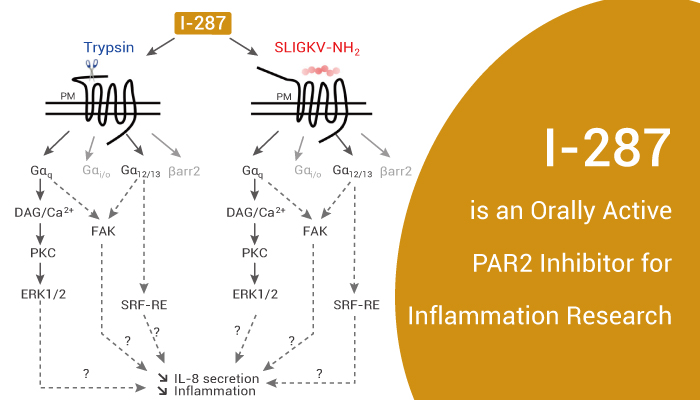Protease-activated receptor-2 (PAR2) belongs to the group of G protein-coupled receptors. It is expressed by a variety of immune cells, several inflammatory and pain responses associated with immune-mediated inflammatory diseases (IMIDs). It causes keratinocytes, endothelial cells, and epithelial cells to release inflammatory cytokines and chemokines, promoting inflammation. It also promotes the proliferation of fibroblasts and myofibroblasts and the secretion of growth factors such as connective tissue growth factor and extracellular matrix components including collagen, further promoting tumor growth and metastasis. Here’ll introduce a potent PAR2 inhibitor, I-287, that suppresses inflammation in in vitro and in vivo rodent models.

I-287 is an orally active, selective inhibitor of PAR2 that blocks inflammation in vivo.
I-287 is a bicyclic heteroaryl derivative that acts as a negative allosteric modulator of Gαq and Gα12/13 activities and their downstream effectors, reducing immune-inflammatory responses. It (0-60 μM; 15-30 min) inhibits PAR2-mediated activation of Gαq, Gα12/13 and ERK1/2 in HEK-293 cells. However, it does not affect the activation of Gi/o proteins, or the recruitment of β arrestin 2 and receptor internalization. It (10 μM; 30 min) also inhibits PAR2-induced IL-8 cytokine secretion in HCT-116 and A549 cells. However, there is no inhibitory effect in tumor necrosis factor-α (TNF-α) stimulated IL-8 secretion, demonstrating the cell specificity of I-287.
In the Complete Freund’s adjuvant (CFA)-induced paw edema model in mice, I-287 (50 mg/kg) can significantly reduce paw swelling and reduce swelling volume. And it has good bioavailability (58% bioavailability) measured in rats.
In conclusion, I-287 is an orally active and selective inhibitor of PAR2 with anti-inflammatory activity in vitro and in vivo.
Reference:
[1]. Avet C, et.al. Commun Biol. 2020 Nov 27;3(1):719.